 W
WThe Arabian Peninsula is a peninsula of Western Asia, situated northeast of Africa on the Arabian Plate. At 3,237,500 km2 (1,250,000 sq mi), the Arabian Peninsula is the largest peninsula in the world.
 W
WAl-Aḥsāʾ, also known as al-Ḥasāʾ (الْحَسَاء) or Hajar (هَجَر), is a traditional oasis historical region in eastern Saudi Arabia whose name is used by the Al-Ahsa Governorate, which makes up much of that country's Eastern Province. The oasis is located about 60 km (37 mi) inland from the coast of the Persian gulf.
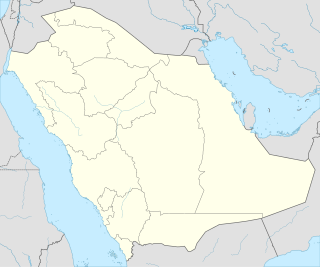 W
WAl-ahsa water spring is a flowing water spring, as described in the book Oasis of Al-Ahsa, by author Federico S. Vidal, which he wrote in 1952 when he was working in the Arabian-American Oil Company (ARAMCO) and he submitted it to Harvard University as a subject for his doctorate degree thesis in 1964. The estimated number of Al-ahsa springs is between sixty and seventy springs, including four huge springs. They flow individually sometimes, or in groups and it is artesian in its flow. The approximate flow of the spring is about 150 thousand gallons in a minute. The springs vary in depth significantly, ranging between 500 feet (150 m) to 600 feet (180 m) and the depth of some of the large springs is just a little off the earth's surface. The water of the spring is warm, the temperature ranges between 80 °F (27 °C) and 90 °F (32 °C), however, some of them are considered as hot springs, with a temperature of over 90 °F (32 °C), and Najim spring counts as one of the hot springs with sulfur water.
 W
WThirteen ancient towns have been discovered in Saudi Arabia up to the present day. These include Qaryat al-Fāw, the Al-Ukhdūd archeological area, Hegra, Jubbah, Tārūt, Al-Shuwayḥaṭiyah, Thāj, Taimaa and Dūmat Al-Jandal. There are still more ancient towns in Saudi Arabia, but little information is currently available on them. Saudi Arabia occupies a unique and distinctive geographic location, bridging civilizations between continents. In ancient times the Arabian peninsula served as a corridor for trade; therefore it saw the beginning of many civilizations, the relics of which are still evident today. The Saudi government has recently established the Saudi Commission for Tourism and Antiquities, which is responsible for the preservation of these cities.
 W
WThe Arab states of the Persian Gulf are the seven Arab states which border the Persian Gulf, namely Bahrain, Kuwait, Iraq, Oman, Qatar, Saudi Arabia and the United Arab Emirates (UAE). All of these states except Iraq are part of the Gulf Cooperation Council (GCC), and prefer to use the term "Arabian Gulf" rather than the historical name of the Persian Gulf.
 W
WArabia Felix was the Latin name previously used by geographers to describe South Arabia, or what is now Yemen.
 W
WThe Arabian Desert is a vast desert wilderness in Western Asia. It stretches from Yemen to the Persian Gulf and Oman to Jordan and Iraq. It occupies most of the Arabian Peninsula, with an area of 2,330,000 square kilometers (900,000 sq mi). It is the fifth largest desert in the world, and the largest in Asia. At its center is Ar-Rub'al-Khali , one of the largest continuous bodies of sand in the world.
 W
WThe Arabian Mau is a formal breed of domestic cat, originated from the desert cat, a short-haired landrace native to the desert of the Arabian Peninsula. It lives in the streets and deserts of the Arabian Peninsula and has adapted very well to its extreme climate. The Arabian Mau is recognized as a formal breed by few fancier and breeder organization and cat registry, World Cat Federation (WCF) and Emirates Feline Federation (EFF). Based on one landrace, the Arabian Mau is a natural breed.
 W
WThe Arabian Peninsula coastal fog desert, also known as the Southwestern Arabian coastal xeric scrub, is desert ecoregion on the southern coasts of the Arabian Peninsula, which experiences thick fogs where visibility may be reduced to 33 feet (10 m). It is classed as an Afrotropical fog desert
 W
WThe Arabian Plate is a minor tectonic plate in the northern and eastern hemispheres.
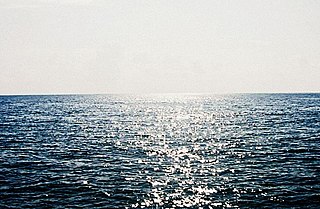 W
WThe Arabian Sea is a region of the northern Indian Ocean bounded on the north by Pakistan, Iran, and the Gulf of Oman, on the west by the Gulf of Aden, Guardafui Channel and the Arabian Peninsula, on the southeast by the Laccadive Sea, on the southwest by the Somali Sea, and on the east by India. Its total area is 3,862,000 km2 (1,491,000 sq mi) and its maximum depth is 4,652 meters (15,262 ft). The Gulf of Aden in the west connects the Arabian Sea to the Red Sea through the strait of Bab-el-Mandeb, and the Gulf of Oman is in the northwest, connecting it to the Persian Gulf.
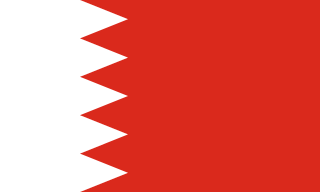 W
WBahrain, officially the Kingdom of Bahrain, is a sovereign state in the Persian Gulf. The island nation comprises a small archipelago made up of 51 natural islands and an additional 33 artificial islands, centered around Bahrain Island which makes up around 83 percent of the country's landmass. The country is situated between the Qatari peninsula and the north eastern coast of Saudi Arabia to which it is connected by the 25-kilometre (16 mi) King Fahd Causeway. According to the 2010 census, Bahrain's population is over 1.2 million, of which around half are non-nationals. At 780 square kilometres (300 sq mi) in size, it is the third-smallest nation in Asia after the Maldives and Singapore. The capital and largest city is Manama.
 W
WEastern Arabian cuisine includes the similar cuisines that are shared by the population in the Eastern Arabia. Seafood is a very significant part of the diet of the inhabitants of the coastal region of Eastern Arabia. Fish is very popular, usually eaten with rice. The cuisine of eastern Arabia is different from the cuisine of the Arabs of Hejaz, Najd and other parts of Arabia. Harees is also a very popular dish in the region.
 W
WGreater Yemen also known as South Arabia is a geographic term denoting territories of historic South Arabia which included the present territory of the Republic of Yemen as well as the Saudi regions of 'Asir, Najran, Jizan, adjacent islands in the Red Sea, adjacent parts of Tihamah and the Omani governorate of Dhofar.
 W
WThe Cooperation Council for the Arab States of the Gulf, originally known as the Gulf Cooperation Council, is a regional intergovernmental political and economic union consisting of all Arab states of the Persian Gulf - Bahrain, Kuwait, Oman, Qatar, Saudi Arabia, and the United Arab Emirates - except Iraq. The Charter of the GCC was signed on 25 May 1981, formally establishing the institution.
 W
WHadhramaut is a region in South Arabia, located mostly in present-day eastern Yemen. The name is of ancient origin, and is retained in the name of the Hadhramaut Governorate of Yemen. The people of Hadhramaut are called Hadhrami. They formerly spoke Hadramautic, but now predominantly speak Hadhrami Arabic.
 W
WQatar is a peninsula with a 563 kilometre-long of coastline, numerous small islets, sandbars, and reefs. It is a popular destination with tourists in the Gulf Cooperation Council.
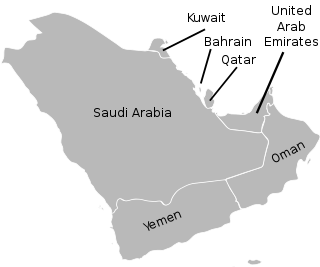 W
WThis is a list of rulers of the Arabian Peninsula.
 W
WA mabkhara is a censer found across the Arab World and Turkey. The mabkhara was traditionally made from clay or soft stone. Most mabkharas have a square pedestal base with inward sloping sides which support a square cup with outward sloping sides. The wooden base is often carved out to form legs. The cup itself is lined with sheet metal. Older burners were decorated with patterned combinations of soft metal pegs and brass tacks, often with mirrors in the panels of the upper part. The legs were ordinarily covered with sheet metal.
 W
WOdeh Spring is a historical natural underground deep sulphur spring in Saudi Arabia, Eastern Province, Qatif, specifically in Tarout Island. Odeh Spring history goes back more than four thousand years. It contained mineral water where people utilized it to cure diseases and illnesses. Odeh Spring used to produce hot water and vapor in winter, and lukewarm water in the summer. In spite of all the different attempts and efforts to revive it, the spring is currently depleted.
 W
WOman, officially the Sultanate of Oman, is a country on the southeastern coast of the Arabian Peninsula in Western Asia and the oldest independent state in the Arab world. Located in a strategically important position at the mouth of the Persian Gulf, the country shares land borders with the United Arab Emirates to the northwest, Saudi Arabia to the west, and Yemen to the southwest, and shares marine borders with Iran and Pakistan. The coast is formed by the Arabian Sea on the southeast and the Gulf of Oman on the northeast. The Madha and Musandam exclaves are surrounded by the UAE on their land borders, with the Strait of Hormuz and the Gulf of Oman forming Musandam's coastal boundaries.
 W
WQatar, officially the State of Qatar, is a country located in Western Asia, occupying the small Qatar Peninsula on the northeastern coast of the Arabian Peninsula. Its sole land border is with neighbouring Gulf Cooperation Council (GCC) monarchy Saudi Arabia to the south, with the rest of its territory surrounded by the Persian Gulf. The Gulf of Bahrain, an inlet of the Persian Gulf, separates Qatar from nearby Bahrain.
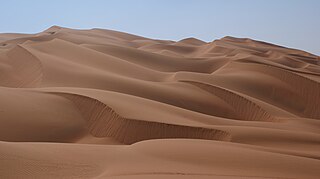 W
WThe Rub' al Khali is the sand desert (erg) encompassing most of the southern third of the Arabian Peninsula. The desert covers some 650,000 km2 (250,000 sq mi) including parts of Saudi Arabia, Oman, the United Arab Emirates, and Yemen. It is part of the larger Arabian Desert.
 W
WThe Rub' al Khali Basin or ar-Rubʻ al-Khālī / ar-rubʿ al-ḵālī Basin, Arabic for "Empty Quarter Basin", is a major endorheic sedimentary basin of approximately 560,000 square kilometres (220,000 sq mi) in southern Saudi Arabia, northeastern Yemen, southeastern Oman and southeasternmost United Arab Emirates. The onshore foreland on Mesozoic rift basin is geographically defined by the eponymous Rub' al Khali and covers the regions of Najran and Riyadh and the Eastern Province. The basin is geologically bound by the Central Arabian Arch in the north, the Oman Thrust in the east, the Northern Hadramaut Arch in the south and the Arabian Shield in the west. Politically, the southwestern boundary is formed by the border with Yemen and the border with Oman forms the southeastern boundary.
 W
WSaudi Arabia, officially the Kingdom of Saudi Arabia, is a country in Western Asia constituting the bulk of the Arabian Peninsula. With a land area of approximately 2,150,000 km2 (830,000 sq mi), Saudi Arabia is geographically the largest sovereign state in Western Asia, the second-largest in the Arab world, the fifth-largest in Asia, and the 12th-largest in the world. Saudi Arabia is bordered by Jordan and Iraq to the north, Kuwait to the northeast, Qatar, Bahrain, and the United Arab Emirates to the east, Oman to the southeast and Yemen to the south; it is separated from the Sinai (Egypt) in the north-west by the Gulf of Aqaba. Saudi Arabia is the only country with both a Red Sea coast and a Persian Gulf coast, and most of its terrain consists of arid desert, lowland and mountains. As of October 2018, the Saudi economy was the largest in the Middle East and the 18th largest in the world. Saudi Arabia also has one of the world's youngest populations, with approximately 50 percent of its population of 34.2 million being under 25 years old.
 W
WTayma or Tema Teman/Tyeman/Yeman is a large oasis with a long history of settlement, located in northwestern Saudi Arabia at the point where the trade route between Yathrib (Medina) and Dumah (al-Jawf) begins to cross the Nefud desert. Tayma is located 264 km southeast of the city of Tabouk, and about 400 km north of Medina. It is located in the western part of An Nafud desert.
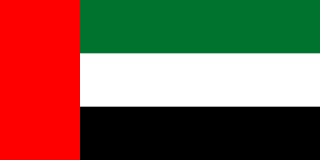 W
WThe United Arab Emirates, sometimes simply called the Emirates, is a sovereign state in Western Asia located at the eastern end of the Arabian Peninsula. It borders Oman and Saudi Arabia, and has maritime borders in the Persian Gulf with Qatar and Iran. It is a federal elective constitutional monarchy formed from a federation of seven emirates, consisting of Abu Dhabi, Ajman, Dubai, Fujairah, Ras Al Khaimah, Sharjah and Umm Al Quwain. Their boundaries have numerous enclaves within each other. Each emirate is governed by a ruler, who together form the Federal Supreme Council, and one of whom serves as President of the United Arab Emirates. In 2013, the UAE's population was 9.2 million, of which 1.4 million were Emirati citizens and 7.8 million were expatriates. The estimated population of the UAE in 2020 was 9.89 million.